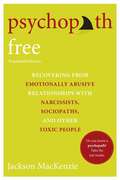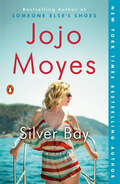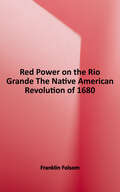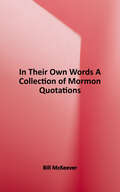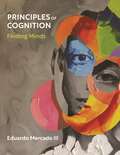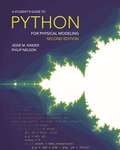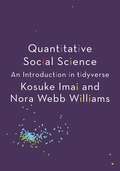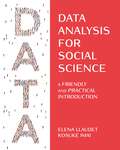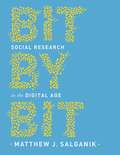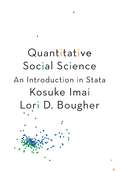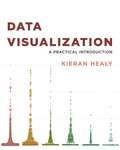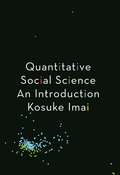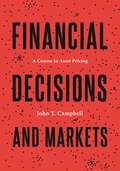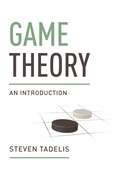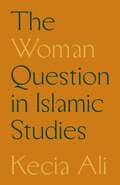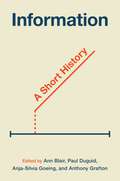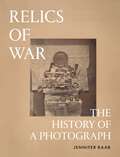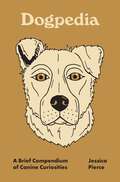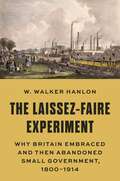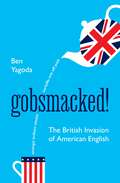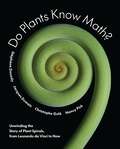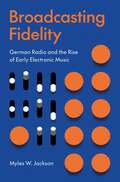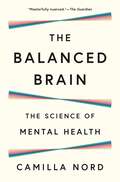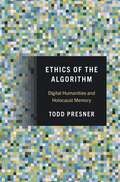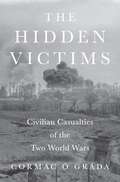- Table View
- List View
Psychopath Free (Expanded Edition): Recovering from Emotionally Abusive Relationships With Narcissists, Sociopaths, and Other Toxic People
by Jackson MacKenzieFrom the author of Whole Again comes a significantly expanded edition of Psychopath Free—containing new chapters, updated content, and real survivor experiences—that will help you recover from emotionally abusive relationships with narcissists, sociopaths, and other toxic people.Have you ever been in a relationship with a psychopath? Chances are, even if you did, you would never know it. Psychopaths are cunning charmers and master manipulators, to the point where you start to accept the most extreme behaviors as normal...Even if it hurts you. All around us, every single day, human beings devoid of empathy are wreaking havoc and destroying lives in the coldest, most heartless ways imaginable. In constant pursuit of money, sex, influence, or simple entertainment, psychopaths will do whatever it takes to gain power over others. They hide behind a veil of normalcy, arranging their friends and partners like pawns in a game of chess. Using false praise and flattery to get what they want, they can lure any unsuspecting target into a relationship. Once hooked, their charming promises spin into mind games and psychological torture. Victims are left devastated and confused, unable to recognize—or even put into words—the nightmare that just took place. Written from the heart, Psychopath Free is the first guide for survivors written by a survivor, offering hope for healing and thriving after psychopathic abuse. Say goodbye to the chaos, self-doubt, and victimization. You are free.
Silver Bay: A Novel
by Jojo MoyesFrom the New York Times bestselling author of Me Before You and One Plus One, in an earlier work available in the U.S. for the first time, a surprising and moving romance set in an old-fashioned seaside town on the verge of unwelcome change Liza McCullen will never fully escape her past. But the unspoiled beaches and tight-knit community of Silver Bay offer the freedom and safety she craves—if not for herself, then for her young daughter, Hannah. That is, until Mike Dormer arrives as a guest in her aunt&’s hotel. The mild-mannered Englishman with his too-smart clothes and distracting eyes could destroy everything Liza has worked so hard to protect: not only the family business and the bay that harbors her beloved whales, but also her conviction that she will never love—never deserve to love—again. For his part, Mike Dormer is expecting just another business deal—an easy job kick-starting a resort in a small seaside town ripe for development. But he finds that he doesn&’t quite know what to make of the eccentric inhabitants of the ramshackle Silver Bay Hotel, especially not enigmatic Liza McCullen, and their claim to the surrounding waters. As the development begins to take on a momentum of its own, Mike&’s and Liza&’s worlds collide in this hugely affecting and irresistible tale full of Jojo Moyes&’s signature humor and generosity.
Red Power on the Rio Grande: The American Revolution of 1680
by Franklin FolsomDetails the causes and events of the Pueblo Indians' revolt against their Spanish rulers in 1680.
In Their Own Words: A Collection of Mormon Quotations
by Bill McKeeverWhen Jesus said, "For out of the abundance of the heart the mouth speaks," He expressed the simple truth that man generally expresses with words what he believes to be true. So, what have Mormons generally believed to be true about their faith? The answer to this question is not always easy to answer. By topically arranging statements made by Mormon leaders, educators, apologists, and lay members, In Their Own Words hopes to assist those who desire to better understand this fascinating religion.
Principles of Cognition: Finding Minds
by Eduardo Mercado IIIA comprehensive overview of what psychologists now know about the nature of cognitionPrinciples of Cognition provides students with an invaluable introduction to the modern science of cognition, blending invaluable insights from behavioral and neuroscientific studies of humans and other animals with unique examples, cutting-edge research summaries, and real-world applications. This accessible textbook builds on the legacy of psychologist William James by emphasizing not only the form cognition takes in laboratory research but also the functional dynamics of cognitive processes in everyday life and the ways they vary across individuals and species. Using an integrative approach that highlights the relevance of cognition across psychological disciplines, it engages students by showing how cognition emerges over time, how cognitive abilities can be improved, and how thinking can be upended by something as simple as falling in love.Discusses topics in cognition rarely covered by other textbooks, including perception of time and space, consciousness, animal cognition, mathematical and reading skills, emotions, intelligence, generalization, and social cognitionEmphasizes learning and its interactions with memory and cognitionFeatures practical applications from cognitive research in every chapterConnects topics across chapters to promote retention and critical thinkingDraws on the latest experimental, naturalistic, and applied researchIntegrates findings about animals and children with traditional studies of adults to develop a more neurally grounded framework for thinking about the mechanisms of cognitionAn ideal textbook for undergraduate and graduate classrooms
A Student's Guide to Python for Physical Modeling: Second Edition
by Jesse M. Kinder Philip NelsonA fully updated tutorial on the basics of the Python programming language for science studentsPython is a computer programming language that has gained popularity throughout the sciences. This fully updated second edition of A Student's Guide to Python for Physical Modeling aims to help you, the student, teach yourself enough of the Python programming language to get started with physical modeling. You will learn how to install an open-source Python programming environment and use it to accomplish many common scientific computing tasks: importing, exporting, and visualizing data; numerical analysis; and simulation. No prior programming experience is assumed.This guide introduces a wide range of useful tools, including:Basic Python programming and scriptingNumerical arraysTwo- and three-dimensional graphicsAnimationMonte Carlo simulationsNumerical methods, including solving ordinary differential equationsImage processingNumerous code samples and exercises—with solutions—illustrate new ideas as they are introduced. This guide also includes supplemental online resources: code samples, data sets, tutorials, and more. This edition includes new material on symbolic calculations with SymPy, an introduction to Python libraries for data science and machine learning (pandas and sklearn), and a primer on Python classes and object-oriented programming. A new appendix also introduces command line tools and version control with Git.
Quantitative Social Science: An Introduction in tidyverse
by Kosuke Imai Nora Webb WilliamsA tidyverse edition of the acclaimed textbook on data analysis and statistics for the social sciences and allied fieldsQuantitative analysis is an essential skill for social science research, yet students in the social sciences and related areas typically receive little training in it. Quantitative Social Science is a practical introduction to data analysis and statistics written especially for undergraduates and beginning graduate students in the social sciences and allied fields, including business, economics, education, political science, psychology, sociology, public policy, and data science. Proven in classrooms around the world, this one-of-a-kind textbook engages directly with empirical analysis, showing students how to analyze and interpret data using the tidyverse family of R packages. Data sets taken directly from leading quantitative social science research illustrate how to use data analysis to answer important questions about society and human behavior.Emphasizes hands-on learning, not paper-and-pencil statisticsIncludes data sets from actual research for students to test their skills onCovers data analysis concepts such as causality, measurement, and prediction, as well as probability and statistical toolsFeatures a wealth of supplementary exercises, including additional data analysis exercises and programming exercisesOffers a solid foundation for further studyComes with additional course materials online, including notes, sample code, exercises and problem sets with solutions, and lecture slides
Data Analysis for Social Science: A Friendly and Practical Introduction
by Kosuke Imai Elena LlaudetAn ideal textbook for complete beginners—teaches from scratch R, statistics, and the fundamentals of quantitative social scienceData Analysis for Social Science provides a friendly introduction to the statistical concepts and programming skills needed to conduct and evaluate social scientific studies. Assuming no prior knowledge of statistics and coding and only minimal knowledge of math, the book teaches the fundamentals of survey research, predictive models, and causal inference while analyzing data from published studies with the statistical program R. It teaches not only how to perform the data analyses but also how to interpret the results and identify the analyses&’ strengths and limitations.Progresses by teaching how to solve one kind of problem after another, bringing in methods as needed. It teaches, in this order, how to (1) estimate causal effects with randomized experiments, (2) visualize and summarize data, (3) infer population characteristics, (4) predict outcomes, (5) estimate causal effects with observational data, and (6) generalize from sample to population.Flips the script of traditional statistics textbooks. It starts by estimating causal effects with randomized experiments and postpones any discussion of probability and statistical inference until the final chapters. This unconventional order engages students by demonstrating from the very beginning how data analysis can be used to answer interesting questions, while reserving more abstract, complex concepts for later chapters.Provides a step-by-step guide to analyzing real-world data using the powerful, open-source statistical program R, which is free for everyone to use. The datasets are provided on the book&’s website so that readers can learn how to analyze data by following along with the exercises in the book on their own computer.Assumes no prior knowledge of statistics or coding.Specifically designed to accommodate students with a variety of math backgrounds. It includes supplemental materials for students with minimal knowledge of math and clearly identifies sections with more advanced material so that readers can skip them if they so choose.Provides cheatsheets of statistical concepts and R code.Comes with instructor materials (upon request), including sample syllabi, lecture slides, and additional replication-style exercises with solutions and with the real-world datasets analyzed. Looking for a more advanced introduction? Consider Quantitative Social Science by Kosuke Imai. In addition to covering the material in Data Analysis for Social Science, it teaches diffs-in-diffs models, heterogeneous effects, text analysis, and regression discontinuity designs, among other things.
Bit by Bit: Social Research in the Digital Age
by Matthew J. SalganikAn innovative and accessible guide to doing social research in the digital ageIn just the past several years, we have witnessed the birth and rapid spread of social media, mobile phones, and numerous other digital marvels. In addition to changing how we live, these tools enable us to collect and process data about human behavior on a scale never before imaginable, offering entirely new approaches to core questions about social behavior. Bit by Bit is the key to unlocking these powerful methods—a landmark book that will fundamentally change how the next generation of social scientists and data scientists explores the world around us.Bit by Bit is the essential guide to mastering the key principles of doing social research in this fast-evolving digital age. In this comprehensive yet accessible book, Matthew Salganik explains how the digital revolution is transforming how social scientists observe behavior, ask questions, run experiments, and engage in mass collaborations. He provides a wealth of real-world examples throughout and also lays out a principles-based approach to handling ethical challenges.Bit by Bit is an invaluable resource for social scientists who want to harness the research potential of big data and a must-read for data scientists interested in applying the lessons of social science to tomorrow’s technologies.Illustrates important ideas with examples of outstanding researchCombines ideas from social science and data science in an accessible style and without jargonGoes beyond the analysis of “found” data to discuss the collection of “designed” data such as surveys, experiments, and mass collaborationFeatures an entire chapter on ethicsIncludes extensive suggestions for further reading and activities for the classroom or self-study
Quantitative Social Science: An Introduction in Stata
by Kosuke Imai Lori D. BougherThe Stata edition of the groundbreaking textbook on data analysis and statistics for the social sciences and allied fieldsQuantitative analysis is an increasingly essential skill for social science research, yet students in the social sciences and related areas typically receive little training in it—or if they do, they usually end up in statistics classes that offer few insights into their field. This textbook is a practical introduction to data analysis and statistics written especially for undergraduates and beginning graduate students in the social sciences and allied fields, such as business, economics, education, political science, psychology, sociology, public policy, and data science.Quantitative Social Science engages directly with empirical analysis, showing students how to analyze data using the Stata statistical software and interpret the results—it emphasizes hands-on learning, not paper-and-pencil statistics. More than fifty data sets taken directly from leading quantitative social science research illustrate how data analysis can be used to answer important questions about society and human behavior.Proven in classrooms around the world, this one-of-a-kind textbook features numerous additional data analysis exercises, and also comes with supplementary teaching materials for instructors.Written especially for students in the social sciences and allied fields, including business, economics, education, psychology, political science, sociology, public policy, and data scienceProvides hands-on instruction using Stata, not paper-and-pencil statisticsIncludes more than fifty data sets from actual research for students to test their skills onCovers data analysis concepts such as causality, measurement, and prediction, as well as probability and statistical toolsFeatures a wealth of supplementary exercises, including additional data analysis exercises and interactive programming exercisesOffers a solid foundation for further studyComes with additional course materials online, including notes, sample code, exercises and problem sets with solutions, and lecture slides
Data Visualization: A Practical Introduction
by Kieran HealyAn accessible primer on how to create effective graphics from dataThis book provides students and researchers a hands-on introduction to the principles and practice of data visualization. It explains what makes some graphs succeed while others fail, how to make high-quality figures from data using powerful and reproducible methods, and how to think about data visualization in an honest and effective way.Data Visualization builds the reader’s expertise in ggplot2, a versatile visualization library for the R programming language. Through a series of worked examples, this accessible primer then demonstrates how to create plots piece by piece, beginning with summaries of single variables and moving on to more complex graphics. Topics include plotting continuous and categorical variables; layering information on graphics; producing effective “small multiple” plots; grouping, summarizing, and transforming data for plotting; creating maps; working with the output of statistical models; and refining plots to make them more comprehensible.Effective graphics are essential to communicating ideas and a great way to better understand data. This book provides the practical skills students and practitioners need to visualize quantitative data and get the most out of their research findings.Provides hands-on instruction using R and ggplot2Shows how the “tidyverse” of data analysis tools makes working with R easier and more consistentIncludes a library of data sets, code, and functions
Quantitative Social Science: An Introduction
by Kosuke ImaiAn introductory textbook on data analysis and statistics written especially for students in the social sciences and allied fieldsQuantitative analysis is an increasingly essential skill for social science research, yet students in the social sciences and related areas typically receive little training in it—or if they do, they usually end up in statistics classes that offer few insights into their field. This textbook is a practical introduction to data analysis and statistics written especially for undergraduates and beginning graduate students in the social sciences and allied fields, such as economics, sociology, public policy, and data science.Quantitative Social Science engages directly with empirical analysis, showing students how to analyze data using the R programming language and to interpret the results—it encourages hands-on learning, not paper-and-pencil statistics. More than forty data sets taken directly from leading quantitative social science research illustrate how data analysis can be used to answer important questions about society and human behavior.Proven in the classroom, this one-of-a-kind textbook features numerous additional data analysis exercises and interactive R programming exercises, and also comes with supplementary teaching materials for instructors.Written especially for students in the social sciences and allied fields, including economics, sociology, public policy, and data scienceProvides hands-on instruction using R programming, not paper-and-pencil statisticsIncludes more than forty data sets from actual research for students to test their skills onCovers data analysis concepts such as causality, measurement, and prediction, as well as probability and statistical toolsFeatures a wealth of supplementary exercises, including additional data analysis exercises and interactive programming exercisesOffers a solid foundation for further studyComes with additional course materials online, including notes, sample code, exercises and problem sets with solutions, and lecture slidesLooking for a more accessible introduction? Consider Data Analysis for Social Science by Elena Llaudet and Kosuke Imai, which teaches from scratch and step-by-step the fundamentals of survey research, predictive models, and causal inference. It covers descriptive statistics, the difference-in-means estimator, simple linear regression, and multiple linear regression.
Financial Decisions and Markets: A Course in Asset Pricing
by John Y. CampbellFrom the field's leading authority, the most authoritative and comprehensive advanced-level textbook on asset pricingIn Financial Decisions and Markets, John Campbell, one of the field&’s most respected authorities, provides a broad graduate-level overview of asset pricing. He introduces students to leading theories of portfolio choice, their implications for asset prices, and empirical patterns of risk and return in financial markets. Campbell emphasizes the interplay of theory and evidence, as theorists respond to empirical puzzles by developing models with new testable implications. The book shows how models make predictions not only about asset prices but also about investors&’ financial positions, and how they often draw on insights from behavioral economics.After a careful introduction to single-period models, Campbell develops multiperiod models with time-varying discount rates, reviews the leading approaches to consumption-based asset pricing, and integrates the study of equities and fixed-income securities. He discusses models with heterogeneous agents who use financial markets to share their risks, but also may speculate against one another on the basis of different beliefs or private information. Campbell takes a broad view of the field, linking asset pricing to related areas, including financial econometrics, household finance, and macroeconomics. The textbook works in discrete time throughout, and does not require stochastic calculus. Problems are provided at the end of each chapter to challenge students to develop their understanding of the main issues in financial economics.The most comprehensive and balanced textbook on asset pricing available, Financial Decisions and Markets is an essential resource for all graduate students and practitioners in finance and related fields.Integrated treatment of asset pricing theory and empirical evidenceEmphasis on investors&’ decisionsBroad view linking the field to financial econometrics, household finance, and macroeconomicsTopics treated in discrete time, with no requirement for stochastic calculusSolutions manual for problems available to professors
Game Theory: An Introduction
by Steven TadelisThe definitive introduction to game theoryThis comprehensive textbook introduces readers to the principal ideas and applications of game theory, in a style that combines rigor with accessibility. Steven Tadelis begins with a concise description of rational decision making, and goes on to discuss strategic and extensive form games with complete information, Bayesian games, and extensive form games with imperfect information. He covers a host of topics, including multistage and repeated games, bargaining theory, auctions, rent-seeking games, mechanism design, signaling games, reputation building, and information transmission games. Unlike other books on game theory, this one begins with the idea of rationality and explores its implications for multiperson decision problems through concepts like dominated strategies and rationalizability. Only then does it present the subject of Nash equilibrium and its derivatives.Game Theory is the ideal textbook for advanced undergraduate and beginning graduate students. Throughout, concepts and methods are explained using real-world examples backed by precise analytic material. The book features many important applications to economics and political science, as well as numerous exercises that focus on how to formalize informal situations and then analyze them.Introduces the core ideas and applications of game theoryCovers static and dynamic games, with complete and incomplete informationFeatures a variety of examples, applications, and exercisesTopics include repeated games, bargaining, auctions, signaling, reputation, and information transmissionIdeal for advanced undergraduate and beginning graduate studentsComplete solutions available to teachers and selected solutions available to students
The Woman Question in Islamic Studies
by Kecia AliThe interconnected ways that sexism functions in academic Islamic studies and how to shift professional norms toward parityDespite remarkable shifts in the demographics of Islamic studies in recent decades, the field continues to be dominated by men, who often relegate other scholars and their work—particularly research on gender—to its periphery, while treating subfields in which men predominate as more rigorous and central. In The Woman Question in Islamic Studies, Kecia Ali explores the interconnected ways that sexism functions in academic Islamic studies. Examining publications, citations, curricula, and media representations, Ali finds that, despite the growth and depth of scholarship on Islam and gender, men continue to overlook women&’s scholarship, even in work that purports to discuss gender issues. Moreover, media and social media dynamics make talking about Islam and Muslims for broader audiences especially fraught for scholars who are not men, particularly when the topic is gender or sexuality.Combining broad surveys with more focused analyses of a smaller set of texts, Ali shows that textbooks and syllabi continue to exclude women as historical actors and scholars and to marginalize gender and sexuality as subject matter. Finally, she provides a &“Beginner&’s Guide to Eradicating Sexism in Islamic Studies," offering practical strategies to help scholars avoid common pitfalls in their own work and contribute to broader professional transformations.
Information: A Short History
by Ann Blair, Paul Duguid, Anja-Silvia Goeing, and Anthony GraftonAn essential guide to the ways information has shaped and been shaped by societiesThanks to recent advances, we now enjoy seemingly unlimited access to information. How did information become so central to our everyday lives? This book traces the global emergence of information practices and technologies across pivotal epochs and regions, providing invaluable historical perspectives on the ways information has shaped and been shaped by societies. Featuring the core articles from the ultimate reference book Information: A Historical Companion, this short history will appeal to anyone seeking to understand our modern mania for an informed existence. The book:Tells the story of information&’s rise from the premodern era to today, exploring how diverse cultures have created, managed, and shared facts and knowledgeTakes readers from the medieval Islamic world to late imperial East Asia, and from early modern and modern Europe to contemporary North AmericaCovers a broad range of topics, such as networks, bureaucracy, publicity, propaganda, censorship, privacy, intellectual property, digitization, telecommunications, storage and search, and much moreIncludes a new introduction, suggested further readings, and a glossary of key termsBrings together an international team of experts, including Jeremy Adelman, Devin Fitzgerald, John-Paul Ghobrial, Lisa Gitelman, Randolph C. Head, Richard R. John, Elias Muhanna, Thomas S. Mullaney, Carla Nappi, Craig Robertson, Daniel Rosenberg, Will Slauter, and Heidi Tworek
Relics of War: The History of a Photograph
by Jennifer RaabHow a single haunting image tells a story about violence, mourning, and memoryIn 1865, Clara Barton traveled to the site of the notorious Confederate prison camp in Andersonville, Georgia, where she endeavored to name the missing and the dead. The future founder of the American Red Cross also collected their relics—whittled spoons, woven reed plates, a piece from the prison&’s &“dead line,&” a tattered Bible—and brought them back to her Missing Soldiers Office in Washington, DC, presenting them to politicians, journalists, and veterans&’ families before having them photographed together in an altar-like arrangement. Relics of War reveals how this powerful image, produced by Mathew Brady, opens a window into the volatile relationship between suffering, martyrdom, and justice in the wake of the Civil War.Jennifer Raab shows how this photograph was a crucial part of Barton&’s efforts to address the staggering losses of a war in which nearly half of the dead were unnamed and from which bodies were rarely returned home for burial. The Andersonville relics gave form to these absent bodies, offered a sacred site for grief and devotion, mounted an appeal on behalf of the women and children left behind, and testified to the crimes of war. The story of the photograph illuminates how military sacrifice was racialized as political reconciliation began, and how the stories of Black soldiers and communities were silenced.Richly illustrated, Relics of War vividly demonstrates how one photograph can capture a precarious moment in history, serving as witness, advocate, evidence, and memory.
Dogpedia: A Brief Compendium of Canine Curiosities (Pedia Books #9)
by Jessica PierceAn enchanting, fact-filled treasury for the dog lover in all of us, from A to ZDogpedia is your gateway into the astonishing world of dogs. Featuring dozens of alphabetical entries on topics ranging from the wonders of dog evolution to the intricate ways dogs communicate with humans and each other, this enticing, pocket-friendly collection helps you to see dogs with new eyes and celebrate the amazing tapestry of our shared existence.Explore the remarkable interplay between humans and dogs with every turn of the page and discover how dogs have played starring roles in history, literature, and art. Immerse yourself in fun facts about dog biology and behavior, from appeasement signals and barking to counter surfing, dominance, growling, scent marking, and zoomies. Learn what fossilized poop can tell us about the history of dog domestication, how dogs in Siberia evolved adaptations to help them thrive in a frigid climate, how dogs have been weaponized for war and colonization, and why we refer to dogs as curs, mutts, and hounds. Meet famous dogs such as Argos, Balto, Boji, and Laika, and marvel at the interwoven destinies of our species and the profound impact dogs have had on our evolution, culture, and everyday lives.With captivating drawings that bring the entries to life, Dogpedia uncovers the enigma of dogs, revealing hidden treasures behind every wagging tail.Features a cloth cover with an elaborate foil-stamped design
The Laissez-Faire Experiment: Why Britain Embraced and Then Abandoned Small Government, 1800–1914
by W. Walker HanlonWhy Britain&’s attempt at small government proved unable to cope with the challenges of the modern worldIn the nineteenth century, as Britain attained a leading economic and political position in Europe, British policymakers embarked on a bold experiment with small and limited government. By the outbreak of the First World War, however, this laissez-faire philosophy of government had been abandoned and the country had taken its first steps toward becoming a modern welfare state. This book tells the story of Britain&’s laissez-faire experiment, examining why it was done, how it functioned, and why it was ultimately rejected in favor of a more interventionist form of governance.Blending insights from modern economic theory with a wealth of historical evidence, W. Walker Hanlon traces the slow expansion of government intervention across a broad spectrum of government functions in order to understand why and how Britain gave up on laissez-faire. It was not abandoned because Britain&’s leaders lost faith in small government as some have suggested, nor did it collapse under the growing influence of working-class political power. Instead, Britain&’s move away from small government was a pragmatic and piecemeal response—by policymakers who often deeply believed in laissez-faire—to the economic forces unleashed by the Industrial Revolution.
Gobsmacked!: The British Invasion of American English
by Ben YagodaA spot-on guide to how and why Americans have become so bloody keen on Britishisms—for good or illThe British love to complain that words and phrases imported from America—from French fries to Awesome, man!—are destroying the English language. But what about the influence going the other way? Britishisms have been making their way into the American lexicon for more than 150 years, but the process has accelerated since the turn of the twenty-first century. From acclaimed writer and language commentator Ben Yagoda, Gobsmacked! is a witty, entertaining, and enlightening account of how and why scores of British words and phrases—such as one-off, go missing, curate, early days, kerfuffle, easy peasy, and cheeky—have been enthusiastically taken up by Yanks.After tracing Britishisms that entered the American vocabulary in the nineteenth century and during the world wars, Gobsmacked! discusses the most-used British terms in America today. It features chapters on the American embrace of British insults and curses, sports terms, and words about food and drinks. The book also explores the American adoption of British spellings, pronunciations, and grammar, and cases where Americans have misconstrued British expressions (for example, changing can&’t be arsed to can&’t be asked) or adopted faux-British usages, like pronouncing divisive as &“divissive.&” Finally, the book offers some guidance on just how many Britishisms an American can safely adopt without coming off like an arse.Rigorously researched and documented but written in a light, conversational style, this is a book that general readers and language obsessives will love. Its revealing account of a surprising and underrecognized language revolution might even leave them, well, gobsmacked.
Do Plants Know Math?: Unwinding the Story of Plant Spirals, from Leonardo da Vinci to Now
by Stéphane Douady Jacques Dumais Christophe Golé Nancy PickA breathtakingly illustrated look at botanical spirals and the scientists who puzzled over themCharles Darwin was driven to distraction by plant spirals, growing so exasperated that he once begged a friend to explain the mystery &“if you wish to save me from a miserable death.&” The legendary naturalist was hardly alone in feeling tormented by these patterns. Plant spirals captured the gaze of Leonardo da Vinci and became Alan Turing&’s final obsession. This book tells the stories of the physicists, mathematicians, and biologists who found themselves magnetically drawn to Fibonacci spirals in plants, seeking an answer to why these beautiful and seductive patterns occur in botanical forms as diverse as pine cones, cabbages, and sunflowers.Do Plants Know Math? takes you down through the centuries to explore how great minds have been captivated and mystified by Fibonacci patterns in nature. It presents a powerful new geometrical solution, little known outside of scientific circles, that sheds light on why regular and irregular spiral patterns occur. Along the way, the book discusses related plant geometries such as fractals and the fascinating way that leaves are folded inside of buds. Your neurons will crackle as you begin to see the connections. This book will inspire you to look at botanical patterns—and the natural world itself—with new eyes.Featuring hundreds of gorgeous color images, Do Plants Know Math? includes a dozen creative hands-on activities and even spiral-plant recipes, encouraging readers to explore and celebrate these beguiling patterns for themselves.
Broadcasting Fidelity: German Radio and the Rise of Early Electronic Music
by Myles W. JacksonA landmark history of early radio in Germany and the quest for broadcast fidelityWhen we turn on a radio or stream a playlist, we can usually recognize the instrument we hear, whether it&’s a cello, a guitar, or an operatic voice. Such fidelity was not always true of radio. Broadcasting Fidelity shows how the problem of broadcast fidelity pushed German scientists beyond the traditional bounds of their disciplines and led to the creation of one of the most important electronic instruments of the twentieth century.In the early days of radio, acoustical distortions made it hard for even the most discerning musical ears to differentiate instruments and voices. The physicists and engineers of interwar Germany, with the assistance of leading composers and musicians, tackled this daunting technical challenge. Research led to the invention in 1930 of the trautonium, an early electronic instrument capable of imitating the timbres of numerous acoustical instruments and generating novel sounds for many musical genres. Myles Jackson charts the broader political and artistic trajectories of this instrument, tracing how it was embraced by the Nazis and subsequently used to subvert Nazi aesthetics after the war and describing how Alfred Hitchcock commissioned a later version of the trautonium to provide the sounds of birds squawking and flapping their wings in his 1963 thriller The Birds.A splendid work of scholarship by an acclaimed historian of science, Broadcasting Fidelity reveals how the interplay of science, technology, politics, and culture gave rise to new aesthetic concepts, innovative musical genres, and the modern discipline of electroacoustics.
The Balanced Brain: The Science of Mental Health
by Camilla NordHow we can use what we&’ve learned about the brain to improve our mental healthThere are many routes to mental well-being. In this groundbreaking book, neuroscientist Camilla Nord offers a fascinating tour of the scientific developments that are revolutionising the way we think about mental health, showing why and how events—and treatments—can affect people in such different ways.In The Balanced Brain, Nord explains how our brain constructs our sense of mental health—actively striving to maintain balance in response to our changing circumstances. While a mentally healthy brain deals well with life&’s turbulence, poor mental health results when the brain struggles with disruption. But just what is the brain trying to balance? Nord describes the foundations of mental health in the brain—from the neurobiology of pleasure, pain and desire to the role of mood-mediating chemicals like dopamine, serotonin and opioids. She then pivots to interventions, revealing how antidepressants, placebos and even recreational drugs work; how psychotherapy changes brain chemistry; and how the brain and body interact to make us feel physically (as well as mentally) healthy. Along the way, Nord explains how the seemingly small things we use to lift our moods—a piece of chocolate, a walk, a chat with a friend—work on the same pathways in our brains as the latest treatments for mental health disorders.Understanding the cause of poor mental health is one of the crucial questions of our time. But the answer is unique to each of us, and it requires finding what helps our brains rebalance and thrive. With so many factors at play, there are more possibilities for recovery and resilience than we might think.
Ethics of the Algorithm: Digital Humanities and Holocaust Memory
by Todd PresnerHow computational methods can expand how we see, read, and listen to Holocaust testimonyThe Holocaust is one of the most documented—and now digitized—events in human history. Institutions and archives hold hundreds of thousands of hours of audio and video testimony, composed of more than a billion words in dozens of languages, with millions of pieces of descriptive metadata. It would take several lifetimes to engage with these testimonies one at a time. Computational methods could be used to analyze an entire archive—but what are the ethical implications of &“listening&” to Holocaust testimonies by means of an algorithm? In this book, Todd Presner explores how the digital humanities can provide both new insights and humanizing perspectives for Holocaust memory and history.Presner suggests that it is possible to develop an &“ethics of the algorithm&” that mediates between the ethical demands of listening to individual testimonies and the interpretative possibilities of computational methods. He delves into thousands of testimonies and witness accounts, focusing on the analysis of trauma, language, voice, genre, and the archive itself. Tracing the affordances of digital tools that range from early, proto-computational approaches to more recent uses of automatic speech recognition and natural language processing, Presner introduces readers to what may be the ultimate expression of these methods: AI-driven testimonies that use machine learning to process responses to questions, offering a user experience that seems to replicate an actual conversation with a Holocaust survivor.With Ethics of the Algorithm, Presner presents a digital humanities argument for how big data models and computational methods can be used to preserve and perpetuate cultural memory.
The Hidden Victims: Civilian Casualties of the Two World Wars (The Princeton Economic History of the Western World)
by Cormac Ó GrádaA staggering new account of the civilian death toll of the world wars—and what it reveals about the true nature and cost of modern warSoldiers have never been the only casualties of wars. But the armies that fought World Wars I and II killed far more civilians than soldiers as they countenanced or deliberately inflicted civilian deaths on a mass scale. By one reputable estimate, 9.7 million civilians and 9 million combatants died in World War I, while World War II killed 25.5 million civilians and 15 million combatants. But in The Hidden Victims, Cormac Ó Gráda argues that even these shocking numbers are almost certainly too low. Carefully evaluating all the evidence available, he estimates that the wars cost not 35 million but some 65 million civilian lives—nearly two-thirds of the 100 million total killed. Indeed, he shows that war-induced famines alone may have killed 30 million people, making them the single largest cause of death.The Hidden Victims is the first book to attempt to measure and describe the full scale of civilian deaths during the world wars, from all causes, including genocide, starvation, aerial bombardment, and disease. While nations went to great lengths to record military casualties, they often didn&’t count or deliberately obscured civilian deaths. Getting the numbers right is important. It reveals much about the true human costs of the wars, the nature of modern warfare, and the failure of efforts to stop civilian casualties. It also makes it possible to argue with those who try to deny, minimize, or exaggerate wartime savagery.
